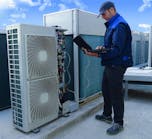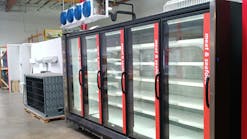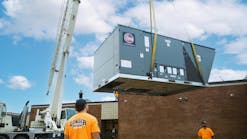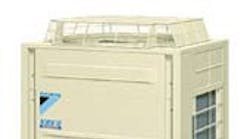Move over rooftops, chillers, DXs, PTACs and VTACs. VRF/ VRV inverter systems are jostling for — and securing — a place at the table.
Variable refrigerant flow (VRF) and variable refrigerant volume (VRV) comfort systems combine one or more centralized, variable speed, air-cooled compressors and condensers connected to fan coil units throughout a building. Each fan coil unit provides heating and cooling on a zone-by-zone basis. Electric resistance coils are also available to provide additional heating, but are only required during the coldest weather (less than 0F).
The Japanese company Daikin invented the variable refrigerant volume (VRV®) concept in 1982. The company has since opened a U.S. headquarters in Carrollton, TX, and — along with the other manufacturers mentioned in this article, and others — is a major provider of these systems.
Since the time of the Daikin innovation, the technology has been adopted by other manufacturers, who describe it as variable refrigerant flow (VRF). Contracting Business recently spoke with system manufacturers and HVAC contractors who are finding success installing VRF/VRV systems.
Daikin VRV Helps Smaller Contractors Compete
Lee Smith, director of product engineering and applications for Daikin AC (Americas), Carrollton, TX, says the Daikin VRV helps level the playing field for smaller HVAC contracting firms.
Smith says the Daikin VRV systems’ modular approach enables contractors to provide quiet, comfortable, energy efficient, large capacity solutions. Multiple zoning needs can be served, thanks to flexible piping capabilities and precise temperature control.
“The Daikin VRV gives contractors opportunities they might not have with traditional comfort equipment, such as chillers or large rooftops,” Smith says. “Generally, only larger contracting companies can support a largertonnage opportunity. If a smaller company can’t get in on the action, their portfolio is limited. The attributes of VRV basically means the system performs just like a chiller, but in a compact, modular format. It uses DX piping, instead of water piping, which contractors are accustomed to installing, and it’s very simple to install from a piping selection point of view,” Smith says.
By installing the modular units in 2-ton increments, contractors trained in the Daikin system need at most a three-person crew to install a 300- ton+ system. The units are also compact and can be transported in building elevators — features that can increase the contractor’s productivity and lead to greater profitability.
Smith says HVAC contractors also appreciate the speed at which they can install the VRV systems, and the subsequent labor and materials savings. Contractors can complete more projects and make more money.
Rob Teetsel, commercial sales engineer for Pro- Tech Air Conditioning & Heating Service, Inc., Orlando, FL, first tried Daikin’s VRV product in 2006. Since that time, the VRV has become a keystone to ProTech’s commercial business.
“I first saw the Daikin VRV specified on a set of blueprints about two and a half years ago,” Teetsel recalls. “Then I had a Design/Build opportunity for an assisted living project that required me to be different from the competition. I called Daikin to see what the system capabilities were on a multi-living building with lots of diverse needs. Daikin personnel provided me with the data I needed, and I presented the VRV system to the owner as one option, in addition to direct expansion (DX) splits, and a VTAC package.
“The owner preferred the Daikin VRV because it required less rooftop equipment than the direct expansion system. It had a built-in controls package, and an energy system the DX couldn’t match.” Pro-Tech begins work on the project in October. Approximately 158 tons of air conditioning will be needed for 108 apartments.
Teetsel has used VRV in other successful projects, including a 5,000 sq.ft. office space that was previously treated with ducted air handlers and a rooftop condenser. He says he’s hard-pressed to find anything he doesn’t like about the Daikin VRV systems.
“There are virtually no installation challenges. They’re small, compact, and easy to install,” he says. “Most of the time, we’re able to give more square footage back to the building owners for usable space, since there are no mechanical rooms. For the office project we reduced ceiling heights and took some structural support out of the building, because we didn’t have the mechanical weights that are required for some of the extended equipment. Amperage was reduced by half, and we still provide very adequate cooling and dehumidification. A three-ton Daikin VRV actually acts like a 3-1/2 to 2-1/2 ton unit. The variable fan motor and variable refrigerant allows it to be more flexible.”
To market the VRV system to potential customers, Teetsel compares forced air/rooftop/VRV systems, and provides energy-use scenarios.
“I also speak to building owners about how they plan to use the facility, what benefits they want, and how each system would interact with the building,” he says.
Teetsel is a member of the U.S. Green Building Council, with a strong interest in green contracting opportunities.
Energy Efficiency Oasis
Randy Williams, owner of Valley Isle Air Conditioning, Maui, HI, is in a virtual paradise with the ducted Fujitsu VRF systems he’s providing for commercial and high-end single resident homes across the Aloha State.
Williams has installed five ducted VRF units at the Pinnacle at Kaanapali, and Lanikeha, high-end housing subdivisions on the island of Maui.
“I’ve always believed that if you’re operating an air conditioning system and giving each room its own control, zoning a 4 or 5-ton system isn’t economical because you’re still running the compressor at full speed. It’s ‘on’ or ‘off,’ and there’s no in-between,” Williams says. “Even with a twospeed compressor, the lower speed will continue to draw a lot of amps.”
Williams appreciates the Fujitsu VRF’s independent control function.
“The VRF system does exactly what I want it to do. Every room has a controller and fan coil unit operating independently, and each VRF system provides efficient control over supply and demand scenarios,” he says. “It can detect that one fan is running at 25%, and the fans and compressor slow down to match the slower rate. The zoning control and efficiency are selling points. The fact that the compressor and fan can reduce speed as demand requires is the major selling point.”
Tim Young, Fujitsu West Coast sales engineer, says VRF systems provide a flexible zoning solution.
“Whether it’s for a commercial building or a residence, we can break it up relatively easily into discreet temperature control zones. That allows us to provide improved comfort, because we have zones that address specific needs based on the building envelope and occupancy,” Young explains.
“We also save energy, because when zones are unoccupied, we don’t need to provide full cooling to those areas. That comes into play whether the indoor unit is a ductless unit or a small duct type.”
Young says VRF systems bring unique opportunities to new construction, by using wall mounts or small fan coil units with a limited amount of ductwork, and having it broken up into zones to improve temperature control.
“And in the retrofit market, opportunities include those existing homes that use baseboard electric heat. There, a contractor can install VRF or mini-split refrigerant piping, where it would otherwise be impractical to try to go with the ducted approach.” To sell these systems, Young says contractors have to communicate the comfort and efficiency benefits.
“When people think of home air conditioning, they think of the central system approach, or a window unit. Successful contractors can explain that the new technology — though certainly more expensive than a window unit from the big box store — provides advantages in efficiency, comfort, appearance, and quiet operation,” Young says.
Consistent Comfort
J.D. McGrath, owner of McGrath Refrigeration, Knox, IN, was faced with a challenging nursing home project in 2004, and solved it with the CITY MULTI Variable Refrigerant Flow Zoning (VRFZ) system from Mitsubishi.
The 17-year-old Pulaski Health Care Center, Winamac, IN, was heated with forced air furnaces. The air conditioning coils were located between the furnaces, and the air handlers that supplied make-up air. Because the burners and fire boxes weren’t made of stainless steel, they were in a serious state of deterioration. McGrath explored the CITY MULTI system and liked what he saw. After a week of training, McGrath begain installing the R2 series, chosen because of its sophisticated controls network, its ability to simultaneously cool and heat different spaces and hallways, its quiet operation, individualized climate control, and low energy usage. “We did our homework and followed the CITY MULTI installation procedures,”
McGrath says. “The installation went flawlessly, and the initial start-up went extremely well.” Follow up calls over the next few weeks justified McGrath’s decision. Tenants and nurses throughout the facility were enjoying consistent temperatures, the systems were running quietly, and energy use was indeed lower than before.
“The biggest selling point of the healthcare center installation was the system’s heat transfer ability,” McGrath says. “Essentially, heat energy is recovered from one space and sent to another. This results in virtually no wasted energy being expelled outdoors.”
Shaun Vig, a commercial HVAC sales representative for Seattle-based distributor Thermal Supply, Inc., distributes Mitsubish VRFZ systems in the Nortwestern U.S. He believes their energy savings and comfort are key benefits.
Vig recently installed the CITY MULTI S-Series in his and his wife’s new 2,300 sq.ft. home. He used a three-ton indoor unit for the main area, and one-ton indoor units for the bonus room and master bedroom.
“The Mitsubishi VRFZ has the potential for considerable energy savings as individual zones are cooled or heated only when they are being used or occupied,” Vig says. “The CITY MULTI R2 VRFZ system may heat and cool simultaneously, providing even more efficiency with heat recovery.
“The VRFZ system allows the fan coil to maintain a constant comfortable discharge air temperature by adjusting the variable speed compressor and the refrigerant metering device. Conventional single-speed compressors will cycle on and off within a preset deadband; whereas, the VRFZ system will reduce the speed of the compressor, reduce the flow of refrigerant and maintain a constant temperature to within one degree.”
Vig believes the comfort and efficiency message should headline the contractor’s VRF marketing program.
“When comparing price between a VRFZ system and conventional ducted systems, the VRFZ system may be slightly more for the equipment, however, the savings will be in the electrical, ductwork and install time,” Vig says.
“The contractor would want to give the owner ‘good-better-best’ options, with the VRFZ system being the ‘better’ or ‘best’ idea, depending on design. Also, explain to the tenant the investment payback that comes with higher efficiencies.”
LG Enters the Market
LG Electronics, Englewood Cliffs, NJ, is expanding beyond its “Art Cool” series of mini-split heat pump air conditioners for homes, to the new Multi V™ series of commercial air conditioners.
The new series — released in June 2008 — marks the debut of the company’s portfolio of applied commercial air conditioning products into the U.S. market. It features design flexibility, efficiency, low noise levels, and one of the longest refrigeration piping lengths available, company sources say.
Steve Schmitt, director, commercial air conditioning, LG Electronics USA, Inc., says the technology is poised for a breakout.
“Even though there have been some products like this in the U.S. HVAC industry for a number of years, we believe the demand for this style of product is going to explode over the next three to five years,” Schmitt says.
Schmitt describes Multi V as a “green” product, in that energy efficiency and complete zoning is achieved due to the system’s design flexibility. “Customers only use the energy required to condition their space due to the Variable Drive Inverter Compressor and advanced environmental controls,” Schmitt says.
“The Multi V Inverter System features serially-arranged refrigerant pipes connected to a single outdoor unit. The Multi V system offers energy savings with a wide variety of indoor units, making it easy to design and install.” LG sources say the Multi V System is especially suitable for hotels, hospitals ,and buildings where space-specific heating/cooling control is essential.
Solving Problems
“The VRF segment of the HVAC industry is growing nicely,” says Davis Watkins, vice president, applied products for Sanyo Commercial Solutions, Kennesaw, GA.
“Unfortunately AHRI isn’t tracking VRF shipments as they do with mini-splits. It’s a small enough segment with a good number of players. Over the past three or four years the segment has grown about 30 to 40% each year, and mini-splits are growing about 20 to 30% each year. For a product segment that’s only been here about eight years, that kind of growth is exciting.”
Watkins says much of the VRF’s appeal is growing due to its compatibility with “problem solving” applications.
“The contractor is the person who’ll propel this into the forefront over time. The VRF allows the contractor to stretch out and take on larger jobs, without increasing overhead,” Watkins says. “It’s a labor-friendly product. The contractor can complete the entire project in-house, and those ‘problem-solving’ scenarios will be encountered and overcome on renovation projects.”
Sanyo introduced the company’s first three-pipe VRF system in 1989. In 2006, it launched the latest generation of electric VRF systems, the ECOi Multi Series, which is designed to be compatible with R-410A refrigerant. The Ecoi uses smaller piping, which company sources says results in lower material costs, easy maintenance, high efficiency, and reduced life cycle costs. Due to the fact that R410A has a higher operating pressure with a lower pressure loss than previous refrigerants, a smaller pipe size can be used, which takes up less space in risers and also leads to reduced material costs.
Opportunity Knocks
It’s clear that VRV/VRF technology’s time has come. Product development has given HVAC contractors more reasons to look at these systems as viable comfort options. And it seems as if customers have nothing to lose in the way of comfort, and much to gain in the way of system efficiency and dependability.









